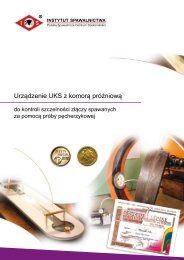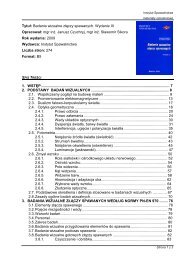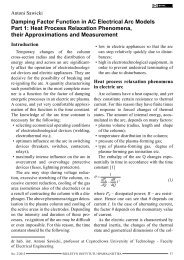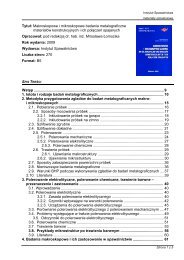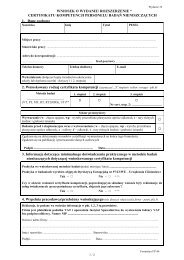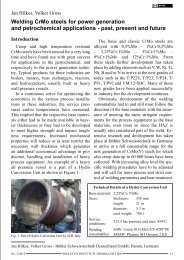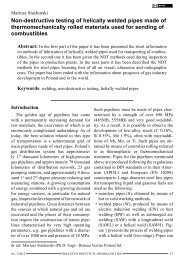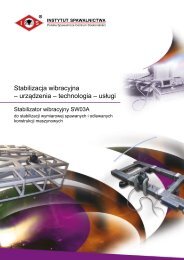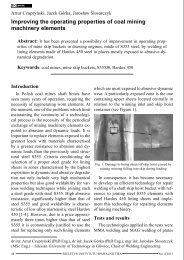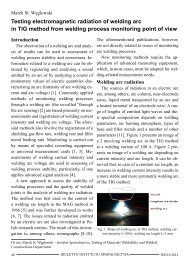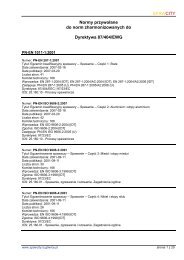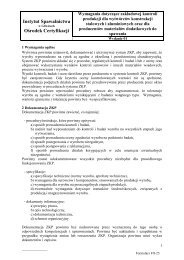Biuletyn Instytutu Spawalnictwa No. 01/2012
Biuletyn Instytutu Spawalnictwa No. 01/2012
Biuletyn Instytutu Spawalnictwa No. 01/2012
You also want an ePaper? Increase the reach of your titles
YUMPU automatically turns print PDFs into web optimized ePapers that Google loves.
ectangular pulse, P i max<br />
=702 W,<br />
penetration depth h=0.93 mm,<br />
face width s=0.87 mm<br />
shaped pulse, P i max<br />
=1584 W,<br />
penetration depth h=1.22 mm,<br />
face width s=0.92 mm<br />
shaped pulse, P i max<br />
=1584 W,<br />
penetration depth h=1.24 mm<br />
face width s=0.79 mm.<br />
shaped pulse, P i max<br />
=1422 W,<br />
penetration depth h=1.10 mm,<br />
face width s=1.30 mm.<br />
Fig. 8. Geometry of penetrations of steel X15CrNiSi20-12 made with<br />
laser beam emitted in pulsed mode with various pulse shapes;<br />
diameter of focusing area 0.3 mm, emission frequency 15 Hz,<br />
pulse energy 4.20 J, pulse duration 6 ms, welding rate 1.8 mm/s [2]<br />
tion of the shape factor (Fig. 6). Impulses of a<br />
different shape having the same energy were<br />
responsible for the formation of incompletely<br />
filled grooves despite the fact that the power<br />
of the pulse was lower [2].<br />
It should be noted that in conditions<br />
of high density of energy<br />
and high power of a pulse, only the<br />
modification of the direction of power<br />
increase or decrease at the beginning<br />
of a pulse may significantly<br />
modify welding conditions.<br />
A pulse with an initial holding<br />
phase and an increase in power at<br />
the final phase is responsible for the<br />
gouging of the material, whereas an<br />
increase in power of the same value<br />
at the beginning of a pulse and further<br />
holding phase make it possible<br />
to obtain a properly-shaped weld.<br />
These relations are different in the<br />
case of a radiation beam of different<br />
power density and pulse energy (Fig.<br />
7, 8).<br />
The appropriate shaping of a laser<br />
beam pulse may have a favourable<br />
effect on the geometry of a weld as<br />
well as positively affect the crystallisation<br />
of a weld. The foregoing<br />
is well exemplified by the melting<br />
(welding) of the aluminium alloy<br />
EN AW-5754 (EN AW-AlMg3). The<br />
penetrations (welds) made with a laser<br />
beam of a rectangular shape were<br />
characterised by the presence of clearly<br />
visible hot cracks (Fig. 9). The<br />
modification of the shape of a pulse<br />
enabled a significant reduction of<br />
these cracks (Fig. 10) [2].<br />
The laser welding of thin plates is often<br />
used to produce overlapping joints, ensuring<br />
high tolerance of the placing of elements being<br />
welded [6].<br />
NR <strong>01</strong>/2<strong>01</strong>2<br />
BIULETYN INSTYTUTU SPAWALNICTWA<br />
11



